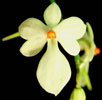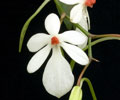|
|
|
|
|
| |
Flasks of
Aerangis luteo-alba var. rhodosticta 'Halcyon' × 'California Sun' |
|
| |
|
|
| |
| Number: |
TN3072 |
| Name: |
Aerangis luteo-alba var. rhodosticta 'Halcyon' × 'California Sun'
|
| Type: |
outcross (What's that?) |
|
Seed Donor: |
Dale Borders
|
|
Click to Enlarge

Pod Parent Flowers |
Click to Enlarge

Pollen Parent Flower |
Click to Enlarge

Offspring '#1' Flower |
| Offspring photos are siblings of the plants you would receive. |
|
|
|
| |
Culture Notes from Donor: Pod parent plant: Temperature range I (60-83°F)
Comments: One of the most popular of the angraecoids. Plants often bloom twice per year or more.
Pod parent plant: The plant supporting the imaged flowers is 3" (7.5 cm) tall, 4" (10.0 cm) wide, and over 20 years old.
For additional origin/habitat information supplied courtesy of
Charles and Margaret Baker, see further below, near the bottom of this page.
|
Temperatures we attempt to use in the lab & greenhouse:
| For Infraspecies: |
|
Spring, Summer, Autumn: days average 78°F, nights 57°F; best fit is cool-intermediate 75-58°F
(Source:
Baker's Web OSC) |
| For Infraspecies: |
|
Winter: days average 72°F, nights 57°F; best fit is cool-intermediate 75-58°F
(Source:
Baker's Web OSC) |
|
About the name...
| Etymology of |
Aerangis |
|
From Greek "aer" air; "angos" vessel.
(Source:
Pridgeon 1992) |
| Etymology of |
luteo-alba |
|
From Latin "luteus" egg-yellow; "albus" white. Yellow-white.
(Source:
Mayr & Schmucker 1998) |
| Etymology of |
rhodosticta |
|
From Latin "rhodostictus" with red dots.
(Source:
Mayr & Schmucker 1998) |
| Pronunciation of |
Aerangis |
|
ah-er-AN-gis
(Source:
Pridgeon 1992) |
| Pronunciation of |
luteo-alba |
|
LOO-tee-oh AL-ba
(Source:
Hawkes 1978) |
| Pronunciation of |
rhodosticta |
|
roe-doe-STIK-ta
(Source:
Hawkes 1978) |
|
If you would like to direct someone to this web page, please copy and paste this URL into your email:
http://troymeyers.com/d?013072
| Flask Information |
| Availability: |
We have sold all of the flasks for this item. |
| You should: |
Consider getting individual plants or compots instead of a flask.
You can place a "Notify Flask Recipients" Request, and either we or a flask recipient may contact you when plants are available.
You may also place a "Notify Retries" Request, and if an identical pollination (the same parents) is done again, we'll let you know.
You may reserve a flask, but it's very unlikely you'll get one ...this could only happen if we found a flask that we didn't know we had. |
| Yield Estimate: |
300 plants (based on flask surveys done 07/22/2003 through 07/23/2003)
|
| Plantlet Sizes: |
From many flasks 20 - 30 mm plants (based on flask surveys done 11/11/2003 )
From one most recently surveyed flask 20 - 30 mm (11/11/2003)
|
|
You might also want to:
|
View the seed assay for this item.
View items of the same species.
View items of the same genus.
|
| Ordering Information |
| You are not currently logged in. |
|
You must be a registered user and be logged in to reserve a flask or place a notification request. Please log in:
|
|
|
|
|
|
| |
The origin/habitat information below is supplied courtesy of Charles and Margaret Baker
The following information is based on the name of the plant provided by the donor, and assumes that the name is correct. If the plant has been misidentified, then the following information may not be correct.
This text is copyrighted by the Bakers and may not be reproduced without permission.
ORIGIN/HABITAT: Africa. The species grows across equatorial Africa from
Cameroons and the Congo Republic in the west through the central and
western forests of Uganda to Somalia, Ethiopia and Kenya in the east. In
Kenya, the plants are usually found at 3000-5000 ft. (910-1520 m) on the
southern and southeastern slopes of Mt. Kenya and on the southern slopes
of Mt. Elgon. Aerangis rhodosticta grows in warm, moist conditions, almost
always in forests along rivers. Plants normally grow in areas well
protected from drought, often near waterfalls. They usually grow on twigs
and branches of shrubs, but are occasionally found on tree trunks.
More about this information and the Bakers...
|
|
|
| |
|
|
|